Arrived in the shelf of compact projectors: Epson EF-100 - the first swallow in a series of bright portable laser projectors
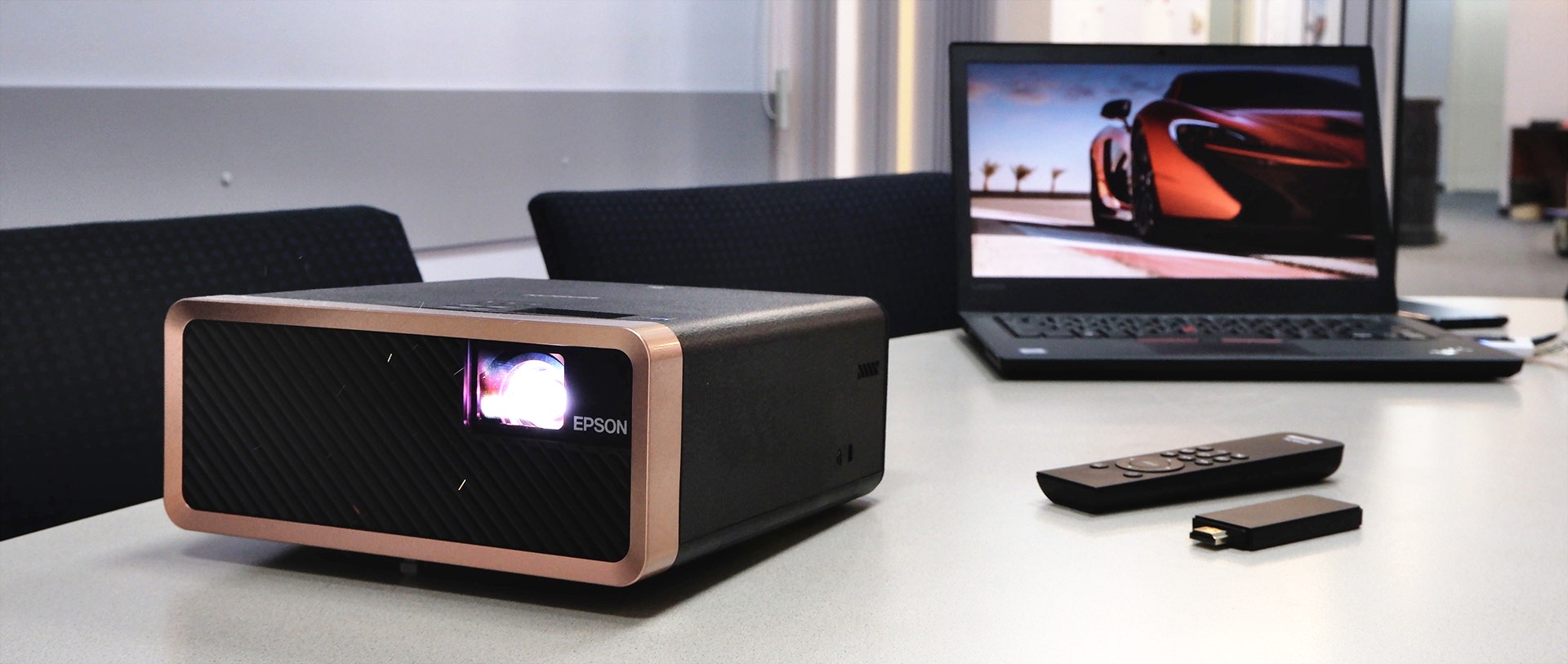
The projector market was flooded with compact LED devices from the Chinese "names" and more or less well-known brands. And each manufacturer is constantly looking for the best engineering solution that will make the device compact, but not much inferior to the "older brothers" in terms of basic indicators.
The “Achilles heel” of LED projectors is their relatively low brightness . It is its lack that limits the options for using a mobile projector, preventing it, for example, from projecting a bright and legible picture onto a wall in a lighted room (as shown in advertising booklets). Yes, what is there - often it’s not even possible to reach the brightness level taken as a minimum (500-700 lm) for comfortable viewing on a diagonal of 100+ inches in the dark even after a significant increase in the dimensions of the LED projector. Of course, we are talking about brightness in the "Cinema" mode or similar, measured by an honest, standard ANSI method , and not "Chinese" lumens.
Epson engineers, having gained experience in the production of large-sized laser installation and home devices, recently decided to try their hand at producing a compact projector based on laser diodes. The result was an Epson EF-100 projector in two versions - in white and black cases - Epson EF-100B and Epson EF-100W .
I’ll tell you about them today.
Laser diode against LED
A schematic diagram and a demo of how the laser light source is arranged in the Epson projector can be found on our website .

I will not delve into the differences between technologies; instead, I will give a link to a specific comparison of technologies with pluses and minuses .
I note the difference, which in our context can be considered the most important: the block of laser diodes allows you to get a higher brightness of the visible light at the same dimensions of the light source compared to the block of "ordinary" LEDs .
For this reason, Epson engineers immediately chose a block of laser diodes as the light source of the “future”. At the same time, in our projectors the laser light source works in tandem with the proprietary 3LCD technology, which is already highly efficient in using the light flux.
Since 2015, expensive and / or superbright models, such as the Epson EH-LS10000 (projector for home theater) and the Epson EB-L25000U (installation projector with a brightness of 25,000 lumens) have left the assembly line. Since then, the Epson line of laser projectors has been continuously replenished with more affordable and compact devices, including office models with a brightness of 4000+ lumens .
Finally, in 2019, a completely new platform was developed, on the basis of which the most compact 3LCD projector to date was built -
Epson EF-100

The case design is very unusual for Epson - it certainly does not look like any of the projectors we previously released. Something reminiscent of vintage audio equipment. The case is covered with soft material "under the skin", it is located just a couple of control buttons. For the sake of this model, they even made a new remote control (they decided to abandon the familiar standard white remote for the sake of a simpler and a bit more elegant).
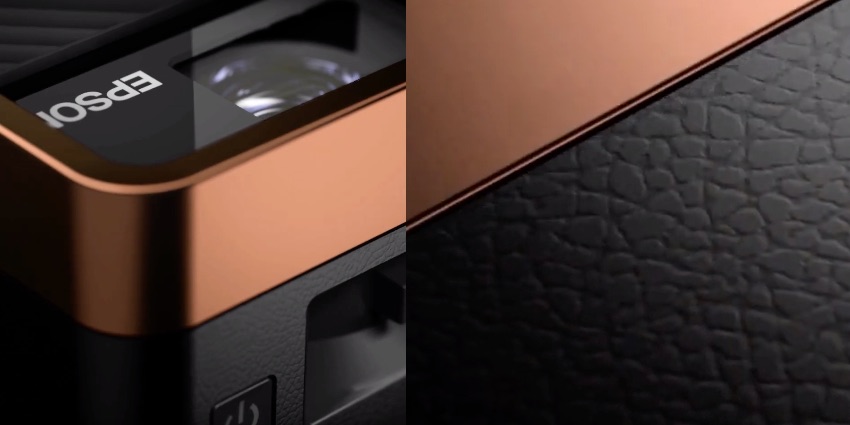
I emphasize that there was no task to create a pocket projector. There was another - to reduce the size of the laser unit and build on its base a mobile laser projector, similar in size to the popular home LED-projectors, which are easy to carry from place to place, but at the same time provide it with brightness at the level of an “adult, lamp” projector, like Epson EH-TW7400 .
No sooner said than done: Epson EF-100 is capable of producing about 1800 ANSI lumens in the most accurate color reproduction mode and more than 2000 ( in white and in color! ) In bright . According to the Epson tradition, even the brightest mode has a fairly high-quality color reproduction (in other words, it does not paint the picture with “green”). The bright mode will be just right, for example, for games or when projecting in very brightly lit rooms.
So, for example, it looks like a projection with a diagonal of about 80 inches in the brightest mode in an office room lit by daylight (a projection of 2000 lumens on such a diagonal turns out so bright that the camera exposes the exposure on it, and not on a light gray wall) :

The compact case and quick installation make it possible to project an image with a diagonal of 80-100 + inches anywhere. On these diagonals and with such a high margin of brightness, the projector is able to brilliantly struggle with weak and medium room illumination.
In addition, the laser light source allows you to smoothly adjust the brightness . With "tube" projectors, it was possible to reduce it to about 70%, putting the device in "Eco" mode. Here you can set any brightness from 50% to 100%. So, in the light we use the “Neutral” mode at a brightness of 1800 lumens, and in complete darkness - at a brightness of 900 lumens (by the way, perhaps the most optimal brightness for a dark room with a screen of 120 inches) .
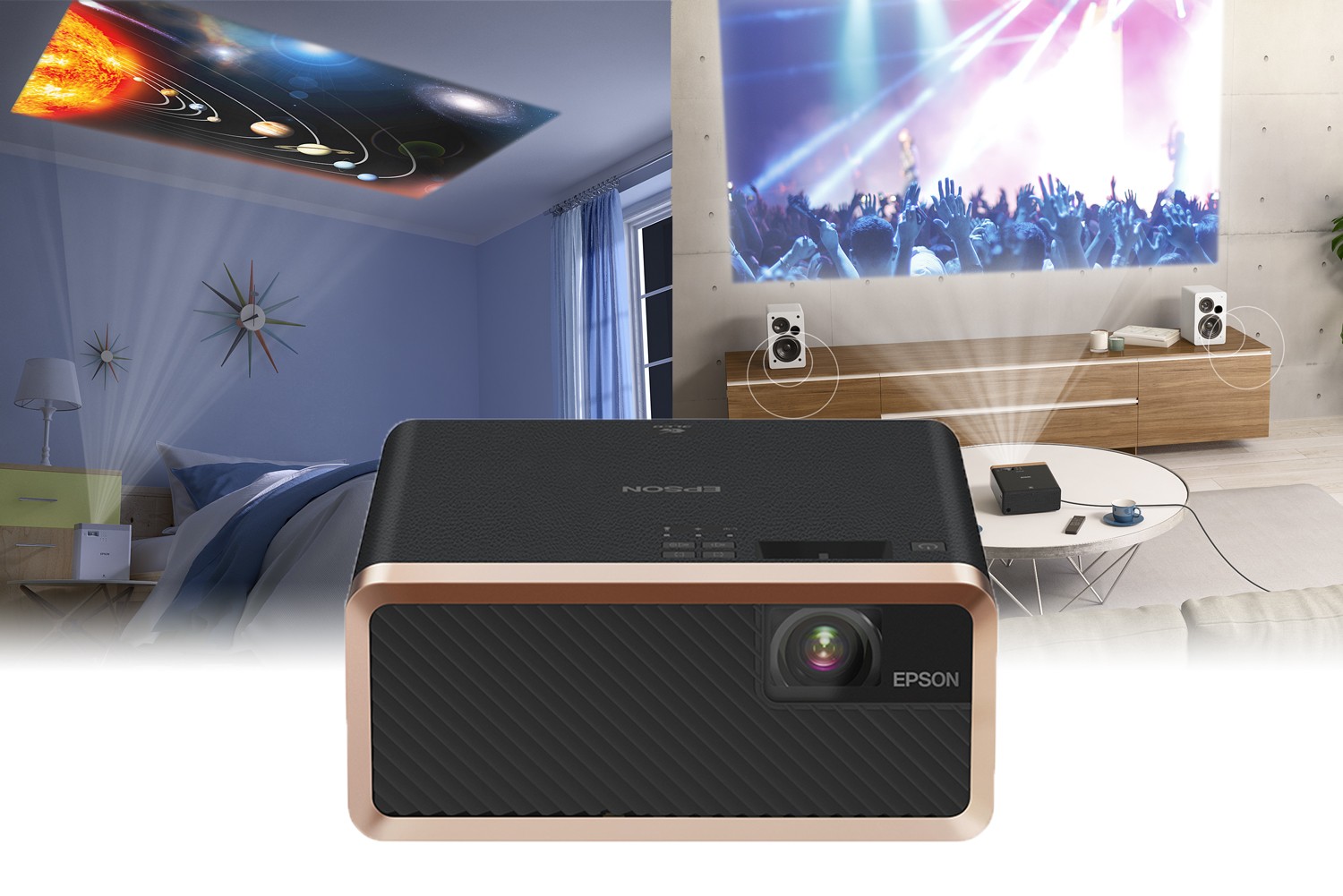
As you know, by reducing the brightness of the laser, we also “save” the black color, minimizing spurious illumination in the room.
Well, for the sake of which many in the first place will look in the direction of this particular model, and not the classic "lamp" - the laser resource is from 12,000 to 20,000 hours, depending on the selected brightness . Combined with quick start-up and fairly short-focus optics (the distance to the screen is approximately equal to the width of the image), the Epson EF-100B is turning into another candidate for the honorable role of a “television substitute” due to its ease of use and the absence of worries about the lamp life.
There is an opinion that it also works much quieter than lamp projectors at maximum power, but I did not have time to check it properly while preparing the post: the last copy was practically pulled out of my hands to be tested in various publications ୧ ༼ ಠ 益 ಠ ༽ ୨ . In the next post on the topic I plan to study this issue.
Very compact
For clarity, I placed the EF-100 next to my favorite Epson EH-TW5650 home lamp projector:
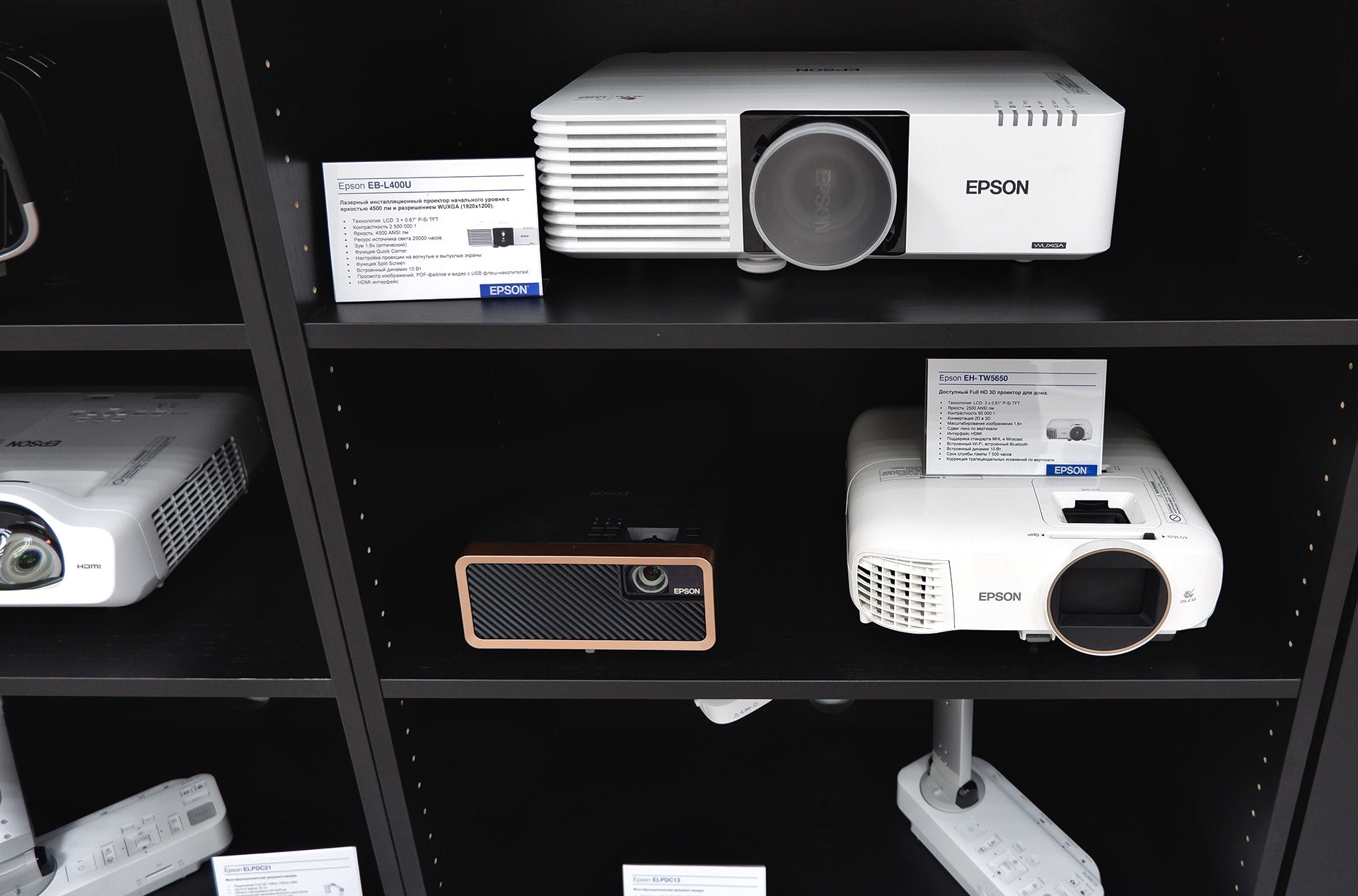
With dimensions of 210 × 230 × 92 mm (W × D × H), the Epson EF-100 currently holds a compact record for a 3LCD projector with a brightness of 2000 lumens.
Works in any position
Another “trump card” of the new device is that thanks to the laser light source, the projector can be installed in any position . That is why the EF-100 has a case of this shape:

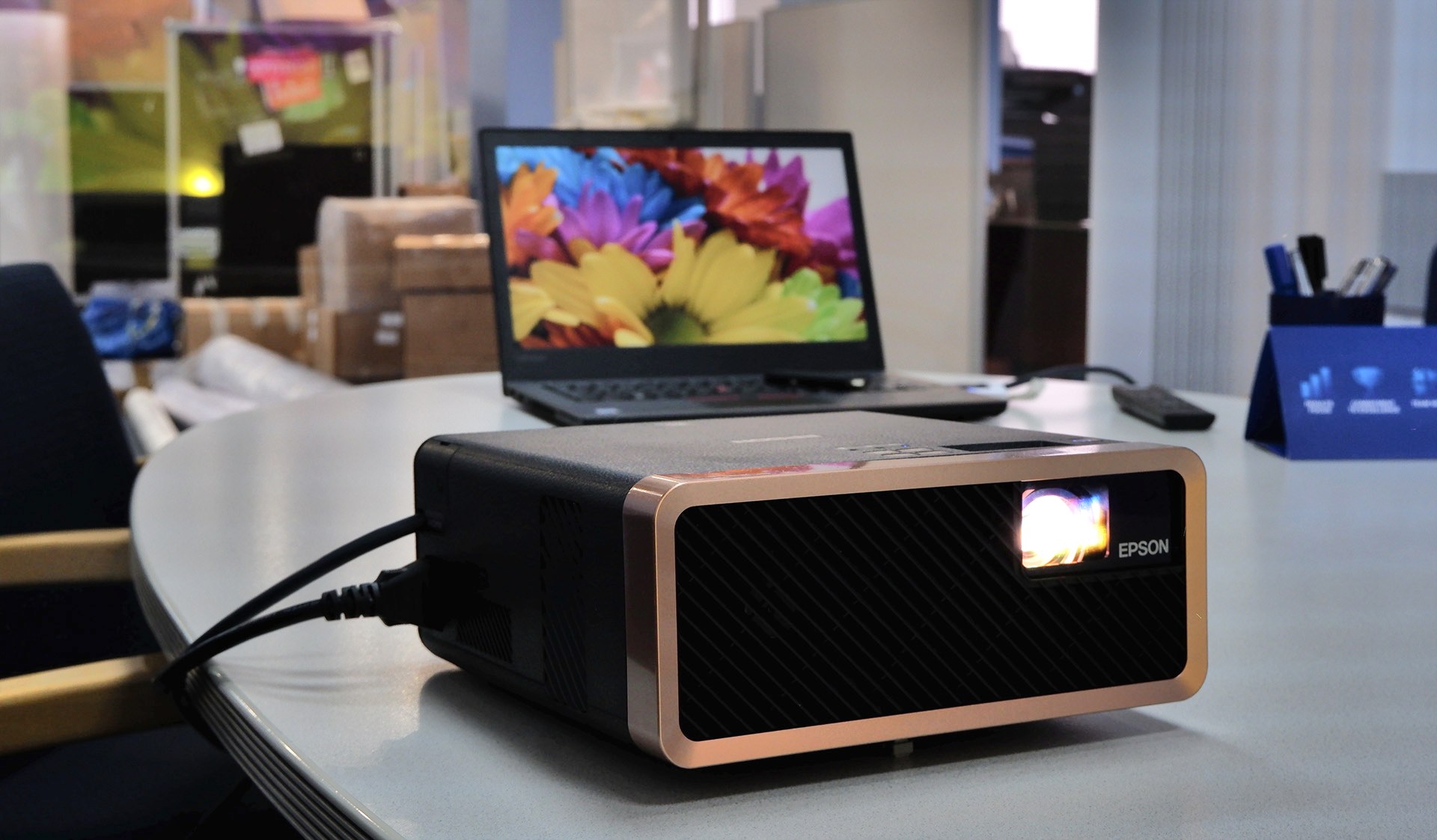
Thanks to the vertical and horizontal keystone correction, the device can be placed at an angle to the wall. Of course, the programmed adjustment of the trapezoid will slightly worsen the sharpness of the image, but in the EF-100 there is such a possibility in principle, while even in projectors of famous brands it can be found infrequently. Range of automatic vertical keystone correction: ± 45 °, manual horizontal: ± 40 °.
The estimated cost of the projector at the moment is about $ 1200.
Turning the Epson EF-100 into a Smart Projector
It's no secret that most pico- and mobile projectors today have built-in “brains” running a particular version of Android OS.
After lengthy debate and discussion, it was decided to dwell on the following option:

Those. As such, the EF-100 does not have its own “brains”, but there is everything necessary so that the user can not only select the “Android” stick at his discretion, but also place it directly in the projector case - there is a microUSB and HDMI power connector port, as well as built-in Bluetooth. For those for whom MicroUSB is not suitable, there is a regular USB port where you can connect the desired power cable. The built-in 5-watt speaker provides sound even in the absence of other audio devices.
The protective net on one side is removed and provides enough space to connect and "hide" the desired device:
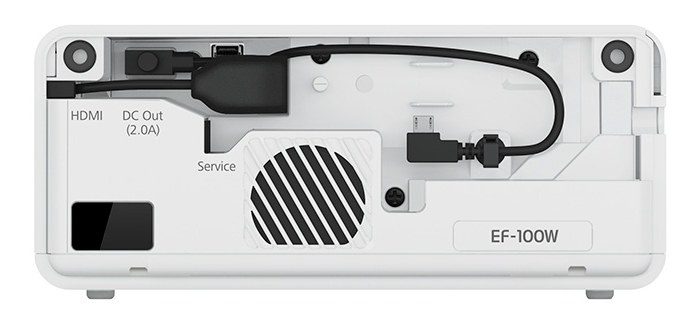
For example, like this:
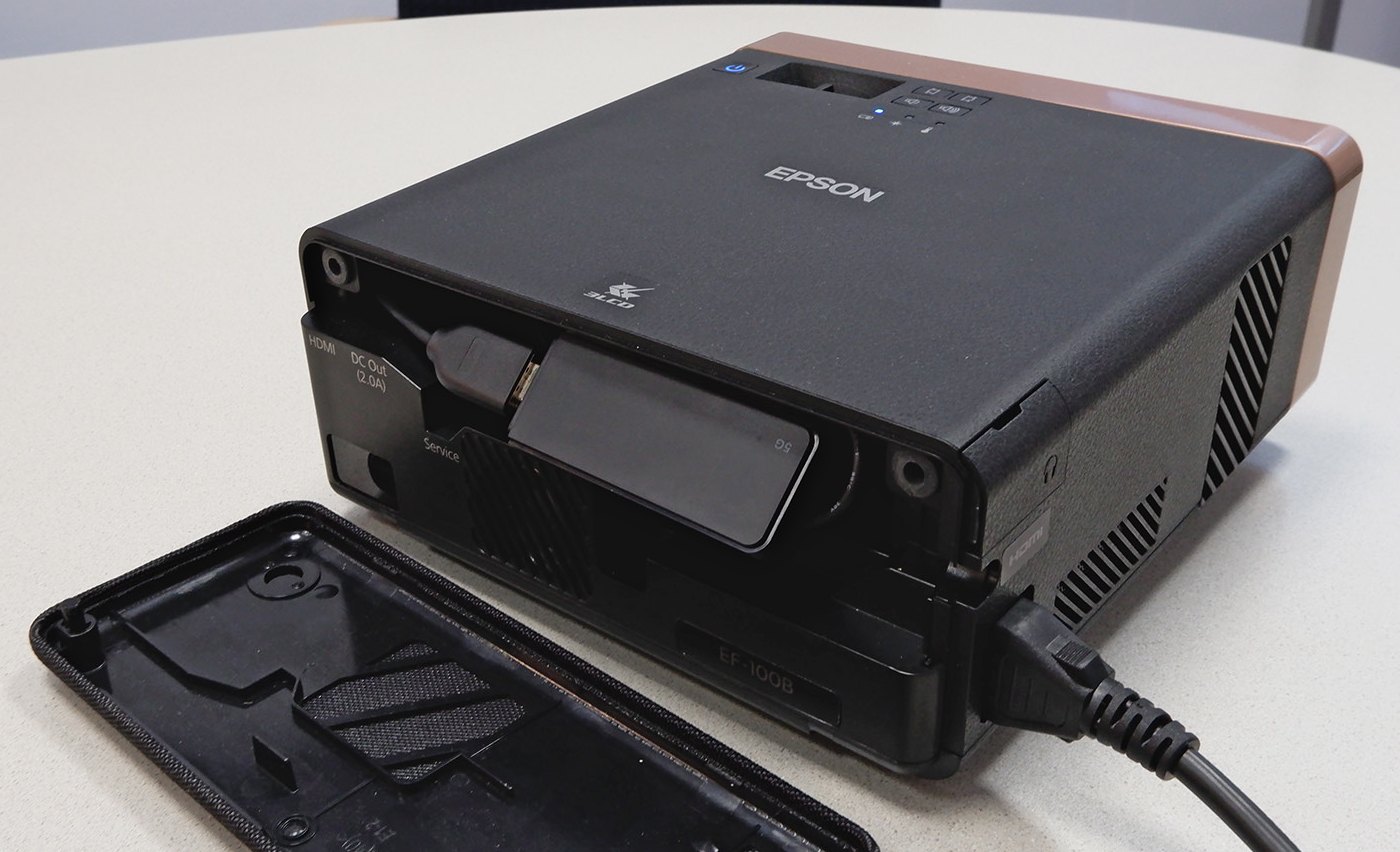
Thus, the Epson EF-100B turns into a Smart projector by installing compact HDMI dongles such as Amazon Fire TV Stick, Roku, or a million others from Aliexpress and eBay in the internal compartment, which is closed by a special panel. With a wired HDMI connection (HDMI 2.0), the rear panel also closes the connector, and the wire comes out from the side (which allows you to place the projector vertically and project the picture onto the ceiling).
The combination of “pros” and “minuses” of such a solution outweighs the “pluses”: the user is not imposed with any kind of “custom” firmware that loses in half only part of the file formats and does not allow the normal installation / operation of third-party software (“omnivorous "MX Player, for example). And the manufacturer is freed from the need to start and maintain a new “zoo” of software and firmware. In addition, failure or some other problems of the external player module will not affect the performance of the projector itself. And those users who consider the EF-100 exclusively as an alternative to the “lamp” model for the home do not overpay for the minicomputer built into the projector.
Hd ready
Due to the need to fit in a compact case a bright laser light source, high-quality optics with a more or less familiar projection ratio, and three high-resolution matrices, a cooling system, as well as provide a place for installing an HDMI dongle, “native” resolution Projector - 1280 × 800 (WXGA / 720p).
I managed to play it in Spider-man on PS4, as well as watch several recordings both in 1080p with downscale up to 720p, and in the original 720p and was impressed. I must say that due to the fact that the focus and brightness throughout the field of the device are very uniform, and the pixels are square (those who came across DLP projectors with a diagonal matrix will understand what I mean), the picture with the EF-100 is very worthy for HD-ready projector. One of the main advantages for many users will be the complete absence of the rainbow effect inherent in most DLP projectors, which is especially noticeable in contrasting scenes (just one of these I have been testing since I assembled my own DC with a “temporary” pico projector) .
Compact laser projector - to the masses
Here he is - the first-born of a new family of projectors "Epson EF". A good option is both in the role of a “long-playing” projector for the home, and in a bright portable device that even the prospect of being used in a lit room will not scare away. Once you look at the bright and juicy picture of the Epson EF-100B, you won’t be able to “see it” and it will be very difficult to refuse the opportunity to get at your disposal an "adult" bright and mobile laser projector in favor of a conventional LED.
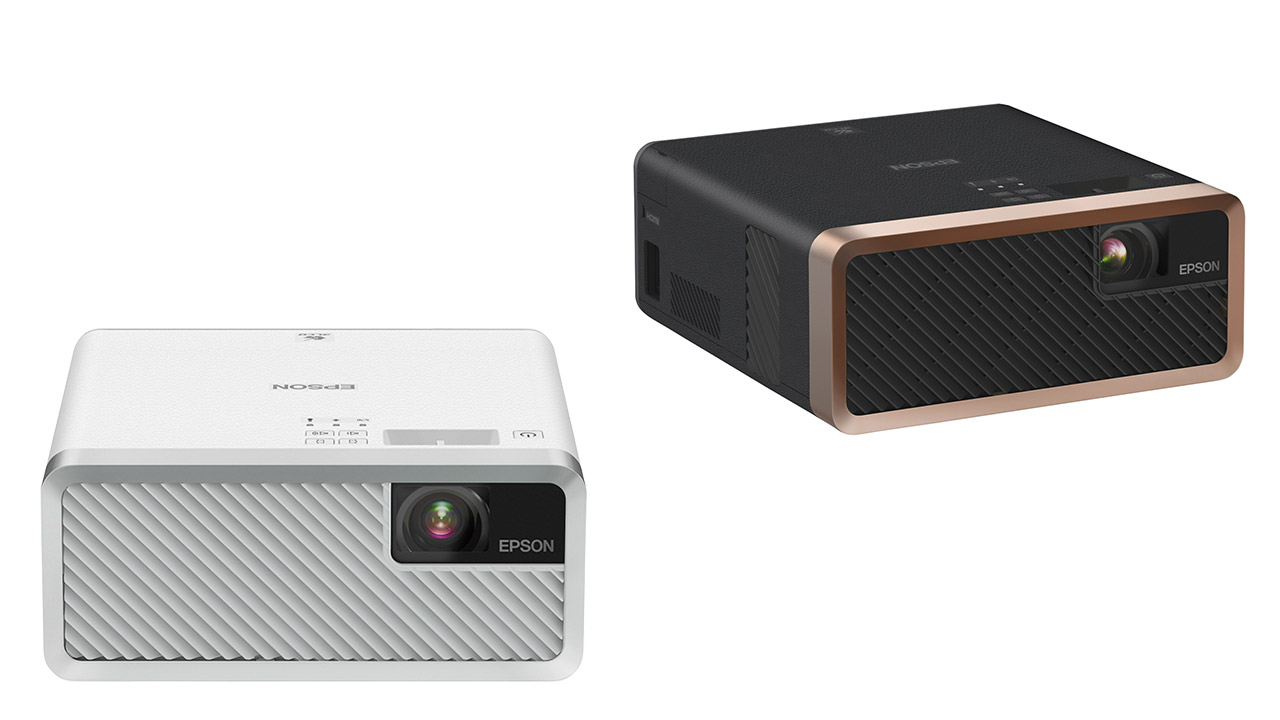
Attention - poll!
All Articles